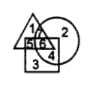JIPMER Aptitude Mock Test 3 - NEET MCQ
10 Questions MCQ Test - JIPMER Aptitude Mock Test 3
The town of Paranda is located on Green lake. The town of Akram is West of Paranda. Tokhada is East of Akhram but West of Paranda. Kakran is East of Bopri but West of Tokhada and Akram. If they are all in the same district, which town is the farthest in West?
Study the following diagram:
There are hard - working workers who are members of the union but not working in factories. Which number indicate this section of workers in the above diagram?


There are hard - working workers who are members of the union but not working in factories. Which number indicate this section of workers in the above diagram?


Arrange the words given below in a meaningful sequence.
1. Index 2. Contents 3. Title 4. Chapters 5. Introduction
1. Index 2. Contents 3. Title 4. Chapters 5. Introduction
If x stands for 'addition', ÷ stands for 'subtraction', + stands for 'multiplication' and - stands for 'division', then
20 x 8 ÷ 8 - 4 + 2 = ?
Which is the Number that comes next in the series:
22, 21, 23, 22, 24, 23, .?
Count each 1 in the following sequence of numbers that is immediately followed by 2, if 2 is not immediately followed by 3. How many such 1's are there ?
1 2 1 3 4 5 1 2 3 5 2 1 2 6 1 4 5 1 1 2 4 1 2 3 2 1 7 5 2 1 2 5
In a class of 35 students, Mohit is placed seventh from the bottom whereas Sunil is placed ninth from the top. Manoj is placed exactly in between the two. What is Mohit’s position from Manoj?
In the following questions, the symbols @, #, $, % and © are used with the following meaning as illustrated below:
'P @ Q' means 'P is smaller than Q'.
'P # Q' means 'P is either smaller than or equal to Q'.
'P $ Q' means 'P is greater than Q'.
'P % Q' means 'P is either greater than or equal to Q'.
'P © Q' means 'P is neither greater than nor smaller than Q'.
Now in each of the following questions assuming the given statements to be true, find out which of the two conclusions I and II given below them is/are definitely true?
Give answer (1) if only Conclusion I is true.
Give answer (2) if only Conclusion II is true.
Give answer (3) if either Conclusion I or II is true.
Give answer (4) if neither Conclusion I nor II is true.
Give answer (5) if both conclusions I and II are true.
Q. Statements : M @ R, R © F, F # L
Conclusions : I. M @ L
II. R @ L
Options
Below are the statements followed by two conclusions numbered I and II. You have to consider the statements and the following conclusions and decide which of the conclusion(s) follows the statement(s).
Statements:
a.All jugs are plates.
b. All plates are cups.
c.All cups are bottles.
Conclusions :
I. Some bottles are jugs.
II. All plates are bottles.














